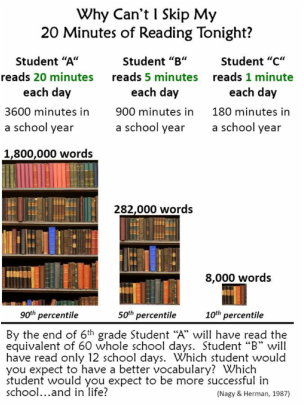 We know that having time to practice a skill is the only way one ever gets better. When children practice a sport their coach watches them try and then gives them advice or models another way to try and they try again. We need to take this same practice into our Read to Self time to help our students grow as readers. There is not a shortage of research that shows the more words or books we read, the better reader and the more vocabulary we will develop. Like the chart below illustrates:  However, if we continue to practice reading words, letters or chunks of words the wrong way we will not advance to higher levels. Therefore, when students, in class or at home are taking the time to read it is important for us as supporters to help them develop new skills, strategies and understanding. How can we help: 1. Be present - offer adult support to assist with the comprehension of the book they are reading and how to figure out new words. 2. Give Choice - to read books they are interested in and help assist your student to read books that are at a just right reading level. (The child should be able to read 98% of the words on their own, with ease, if it is going to be a read to self book.) 3. Embed instruction - by talking to them about what is happening in their book and providing instruction that meets their needs at that moment. . When kids choose books at their level and read silently is often not as silent as we envision silent reading to be. We often hear giggles or comments about what is happening in the book. These sounds are an excellent signs that the child reading the book is able to understand what is happening in the story. The most valuable component of this reading time is that the teacher has the ability to confer with students one -on-one and to assist students with strategies to help them better understand and enjoy what they are reading. As the teacher, I can ask questions, clarify understanding and leave them with a strategy to practice until I meet with them again. Once we have come up with a strategy, I stay long enough for the student to try the strategy, write it down on a bookmark for them and then I can move on to another reader. It is important to have some type of conferring book to keep track of what strategy each student is working on. This allows you to check your notes from your last conference with that student and check to see if they are able to implement the strategy that you worked on last time or if they will need reteaching. The best part of taking time to confer with students is that you are helping students become better readers everyday. This one-on-one instruction meets each individual reader where they are and allows you to support them and move them forward. Happy Reading!
0 Comments
Leave a Reply. |
AuthorVicky Sahlin Current and Previous Blogs
Archives
January 2016
Categories |
- Home
- About Me
- Resume
-
Principal Quality Standards
- Fostering Effective Relationships
- Modeling Commitment to Professional Learning
- Embodying Visionary Leadership
- Leading a Learning Community
- Supporting the Application of Foundational Knowledge about FMNI
- Providing Instructional Leadership
- Developing Leadership Capacity
- Managing School Operations and Resources
- Understanding and Responding to the Larger Societal Context
- Supporting the Division Vision
- Presentations
 RSS Feed
RSS Feed
